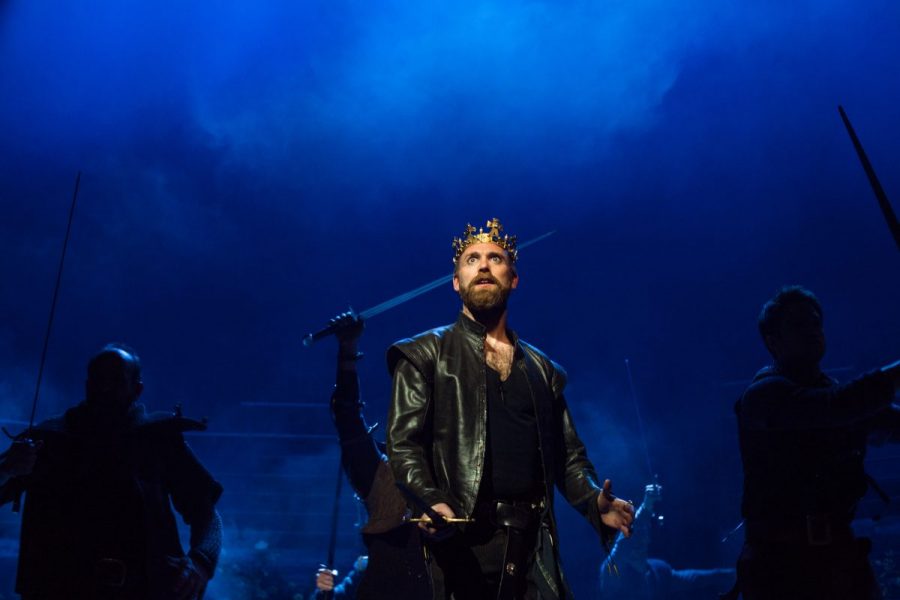@ Festival Theatre, Edinburgh, until Sat 13 Feb 2016 (and touring)
The final episode of Rona Munro‘s James Plays trilogy is its most colourful and lush. Roses now climb the bare wooden walls of the court. Costumes are more extravagant – kilts for the boys, ball gowns for the girls. In its opening scene, the cast are sat around luxuriating at a drinks party. We’re in the late fifteenth century, and if, like Victorian Britain, the eras of James I and James II represented a time of pragmatism, power-broking and displays of might and muscle, then this is the Roaring Twenties, a time to indulge oneself, a time when Anything Goes.
In our main protagonists, James III and Margaret of Denmark, we have the strongest, most commanding pair of characters in the whole of the trilogy. James is a tragicomic work of art – over-sexed, cocky, flamboyant (but with a distinctly macho form of campness), oblivious to consequences, thirsty for experience, fatally indulgent. Margaret is wily, tenacious, diligent, weak for James, strong for Scotland. She’s a world away from the tedious, one-dimensional fairytale Queen Joan of James I and so much better for it. It’s no wonder the Head of the Privy Council, John, wants her to leave her faithless, feckless husband for him.
Unlike in its prequels, the comedy in James III is welcome. It arises naturally from the character of James himself – his flippancy, his foppishness call for a swaggering, dismissive humour – rather than feeling like pre-prepared lines fed to whichever character is most convenient.
He is doomed. His insistence on hiring choirs for himself and stealing people’s property to give to his “favourites” (either gender, any class or occupation – James is a man of catholic sexual tastes) see to that. But he’ll go down in a blaze of glory if he can. Matthew Pidgeon imbues the character with a slightly unhinged overconfidence and is highly watchable.
Meanwhile, Queen Margaret, elegantly played by Malin Crépin, busies herself saving the Kingdom from the King and the King from himself. As the go-between between court and monarch, her loyalties and abilities are stretched, but she never breaks, and ultimately wins round a nation to which she is, even after years in the country, still a stranger.
John (Ali Craig) is the steady, impenetrable opposite to James, and equally set on securing both the state, and, if possible, Margaret herself. But it falls to the future James IV to take a firm hand on the tiller, and Daniel Cahill plays that boy-to-man transition as satisfyingly as his counterparts in the previous James Plays.
It sets up a superb final scene, where… (if you don’t want to see the result, please look away from your screens now)… James IV becomes King, aided by an elderly aunt – the ever-excellent Blythe Duff – in his final preparations. The threads of the trilogy are tied together, and as she tells the young man of his ancestry, it is at last possible to cast an eye across the decades and see that each period has been given its own flavour and style. The three kings, eventually, feel like a dynasty.
And yet, and yet, while it all ends on a high, the play cannot help but try to find a way to ruin itself. Opening each act is a pointlessly gimmicky and anachronistic song-and-dance routine. The cast self-indulgently flounce around to Happy by Pharrell Williams and Don’t You Want Me? by The Human League. A history professor wouldn’t spend years researching a topic, then shoot themselves in the foot by doing the book launch at a karaoke bar wearing a pink leather catsuit. Why sacrifice a play to such cheesiness?
Despite that, it’s still tempting after the climax to call for James IV (and onwards) to follow, but if, and only if, the trajectory of deeper characterisation is followed through and the pointless pop-cultural references completely dispensed with.
